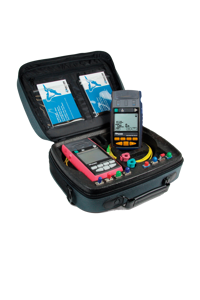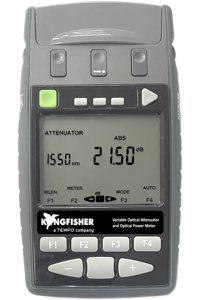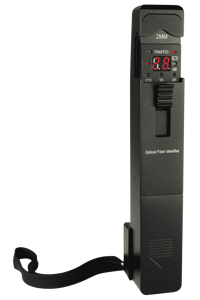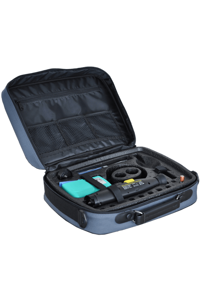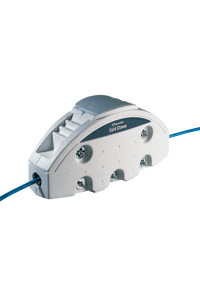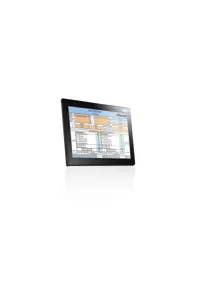Recommended Use
KITS™ Version 4.16 is superseded. User Manual pdf
Pre-requisites, full install
- If upgrading an older version of KITS, manually uninstall the old KITS and reboot the computer before installing the new version.
- Windows 10 to XP.
- OSX - using Parallels or Bootcamp
- Microsoft Office 2016 - 2007. (early builds of 4.16 only work on Office 32 bit)
- KI2000 Instrument firmware V0.05 and above. You would do best to update the firmware to a recent release.
KI7000 Instrument firmware V5 and above.
- Current instruments: USB interface on your computer.
Legacy instruments with an RS232 interface, pre-2008, If your computer doesn't have one, install a suitable RS232 adaptor. Either install this on all USB ports, or mark the correct USB port. If you have a desktop computer, a PCI / PCIE - RS232 adaptor card may be more convenient.
- KITS™ support for non-English language environments is as follows:
English language installations of Microsoft Office require a relevant language Microsoft Office MUI (Multilingual User Interface) to run in another language.
Non-English language installations of Microsoft Office require an English language Microsoft Office MUI.
Pre-requisites, instrument file dump function only
This alternative KITS™ CSV "one button" memory download can be installed on Windows only, eg without needing any MS Office. (also installs with the full version). This is installed on it's own by selecting "compact installation" during KITS™ installation. Does not work on Win XP.
Installation & Connection Issues
Installation options don't seem right
During program installation, options appear only as " Modify, Repair, Remove". This is because a previously installed version of KITS needs to be removed. Select "Remove" to complete the uninstall, re-start the computer, and then re-run the installer.
Support for other languages
KITS™ can display any of the roughly 34 different languages supported by Microsoft in Windows and Office, when configured as follows:
- English language installations of Microsoft Office require a relevant language Microsoft Office MUI (Multilingual User Interface) to run in another language.
- Non-English language installations of Microsoft Office require an English language Microsoft Office MUI.
KITS™ can't find my Kingfisher instrument.
- Ensure that the instrument is turned on and plugged into the computer correctly
- If you are using a USB-to-serial adaptor (legacy instruments only);
- Ensure that the USB-to-serial driver has been installed
- Windows requires that the USB-to-serial driver be individually installed on the USB port used. Hence, please ensure that the adaptor is plugged in to the correct USB port.
- Note that after you have got the adaptor device driver installed correctly, you can then install the instrument device driver.
- If the instrument is successfully connected to the computer but the instrument device driver is not installed, KITS will prompt you to install the device driver when it is started.
A newly installed KITS runs an older dll or Excel template
After installing a new version of KITS, it still runs the old dll (seen by the release date on KITS start up) or Excel template (causing an Excel error). This is most likely caused by the Excel user profile remembering the previous KITS files. You can check this problem by logging on with a different user profile: the problem should go away. If you had uninstalled and re-booted the old version of KITS before installing the new version, this would not have happened. Do the following to fix:
- Uninstall KITS from the system
- Reboot the computer
- Reinstall KITS
- Run KITS and check if the release date is correct
When I run KITS™, I get error message "Old library or incorrect format..."
Your computer is configured to a language that requires installation of a Microsoft MUI (Multi-lingual User Interface) software that is not installed. There are various possible ways to fix this:
- For English Language Installations of Windows / Office: Change the Windows operational language back to English: Go to Start / settings / Control Panel / Regional and Language Options / Regional Options tab. Set both the "standards and formats" drop down to a version of English. Then select the Languages tab, and set all "input language" details to a version of English. "Standards and formats" can be customized.
- For Localized Language (non English) installations of Office: The English Language Office MUI must be installed.
- Leave the computer in the non-standard language, but install the relevant Microsoft Office MUI (Multilingual User Interface).
FAQ - Other Issues
Which build of KITS™ is installed on my computer?
The build date is displayed on the start up splash screen, or start KITS, then go to add-ins tab/Kingfisher/About KITS.
When I start KITS, I just see blank Excel Workbook
If you have upgraded your computer to a Microsoft Office 365 subscription after installing KITS, try uninstalling and reinstalling KITS with the latest download. If this doesn't work, please contact us for support.
Alternatively, if this has just randomly stated happening with no other changes, this is due to a com Addin mis-configuration in the Microsoft Office installation, which can be fixed by following the procedure in the manual - Section 8.2.3. Re-installing or repairing KITS will not fix the problem.
I have a KI7000 USB instrument, Windows 8 - 10, and the USB power keeps turning off
A new windows USB power management feature causes conflict with our low power draw devices. This feature is not affected by your computer power plan, or adjusting accessible driver power management settings. KITS operation is not affected either since the port will turn on for data, but if you're trying to power the instrument from a port, you may have experience some unexpected shutdowns. We have a work-around for you that requires administrative privileges:
To fix:
The KITS device driver must be installed, and then the instrument plugged successively into all of the available USB ports (or physically identify one port to use). that can now be fixed or edited with regedit.
- Ensure the KITS device driver is installed.
- Plug the instrument into all the ports you plan on using. (This will create device driver instance per port).
- Once you have created all the device driver instances, Run our utility, which will usually make the registry changes for you.
Alternately: edit the registry manually. The string to edit on our system was: Computer\HKEY_LOCAL_MACHINE\SYSTEM\CurrentControlSet\Enum\USB\VID_18BE&PID_7000\[multiple instances]\Device Parameters\EnhancedPowerManagementEnabled. Set the DWORD value=0 (value was =1)
Alternatively there is a helpful article on the editing process here.
Alternative workarounds: use a USB charger device to power e.g. a light source, or just leave KITS running.
Where are the KITS™ files located?
Due to security and administration requirements, Windows places application and configuration files in different locations depending on the Window version and how it has been configured. Here are some simple techniques for figuring out where Windows has decided to place application and configuration files.
To locate the KITS™ application files, locate the application shortcut in the start menu, right click it, click properties, and click "find target...". If you have lost the application shortcuts, try looking for either "KITS" or '"Kingfisher" in the default Program Files directory on your computer.
The default location of the standards specification excel files, "Loss Test Standards.xls" and "User-LossTest-Standards.xls" is:
C:\Documents and Settings\All Users\Application Data\Kingfisher\KITS4.
This may be a hidden directory for some users in Windows Explorer.
The decimal point is removed from numbers I enter via the numeric keypad.
For instance, enter 56.78 via the keypad and it is converted to 5678.
This can occur with KITS™ if the default Regional Setting in your configuration for a decimal point has been changed and the decimal point is entered via the numeric keypad.
The reason is that in this circumstance, Windows doesn't recognize the decimal point entered via the numeric keypad as a decimal point.
The work around is to use the decimal point on the main keyboard.
During test setup I receive the error message '... no useful data ...'
KITS™ has been configured for one way testing, but the meter has been configured to be at the source end. You can move the meter to the other end via either configuration or switching the units. For example, to test loss from B to A, the source must be located at B, and the meter must be located at A.
To help avoid this message, consider displaying the test summary layout diagram. Toggle [Setup], [Show Test Summary]
Computer Regional Settings
Rarely, we have seen a program problem due to the computer Regional Settings, which is easy to confuse with a language issue. To identify this: Temporarily change your computer's regional setting to eg USA, and if this solves your problem, or changes the error message, then there is a computer Regional Settings issue. Please contact us for support, so we can fix it.
How do I update, add to or modify the test standards?
The International standards definitions and specifications are located in the XLS file: 'Loss Test Standards.XLS'
This file has been write protected by Kingfisher International. Contact your KI distributor or check the Kingfisher International web site should amendments be required.
The User definable standards definitions and specifications are located in the read only XLS file: 'User-LossTest-Standards.XLS'
User definable standards can be specified here. This file is can be write protected if required. The locations of these files are found in an above FAQ item.
Note that customizations may not translate across languages. If this happens, manually edit modified formulas into the new language.
How do the KI2000 and KI7000 instrument command sets compare?
If you have developed an application for a KI7000 series instrument, and would like to update to a KI2000 series instrument, you will be delighted to know that they use the same command set, so you can use an updated instrument without writing any new code. The only difference is that you will need to install an updated Windows device driver, since it uses the built in windows USB (CDC) driver instead of HID. This device driver is most easily installed by running the KITS™ install, or alternatively by using the device driver file ki2000.inf.


